Capítulo 3: La familia

Sobre el artista: Oswaldo Guayasamín is one of the most recognized artists of his generation in Ecuador. His Quechua heritage inspired him to portray different views of the human condition, including relationships with nature, the family, and the earth. He received international recognition for his technique as he was part of the artistic movement of Expressionism.
Learning Objectives
At the end of this chapter, students will be able to perform the following tasks in Spanish:
- I can talk about my family members and friends
- I can describe myself and others
- I can express possession
- I can discuss daily activities
Vocabulario
Family / Marital Status / Expressions with the verb TENER
Pronunciación
R and RR sounds
Mosaicos culturales
Los compadres (Godparents)
Estructuras gramaticales
3.1 Possessive Adjectives
3.2 Descriptive Adjectives
3.3 Present tense of -ER and -IR verbs
3.4 Present tense of TENER and VENIR
Escritura
Write about your family
Cultura
País: Ecuador
Música: Mirella Cesa
Personalidad: Oswaldo Guayasamín
Lectura
Hispanic Name: ¿Cuál es tu apellido?
Vocabulario: La Familia
| La familia El abuelo (tata) La abuela (nana) El padre (papá, papi) La madre (mamá, mami) La familia materna La familia paterna El hijo/la hija El hermano La hermana El tío La tía El primo La prima El sobrino La sobrina El nieto La nieta La bisabuela El bisabuelo La tatarabuela El tatarabuelo |
Family
grandfather |
|---|
| Los parientes políticos
La cuñada |
In-Laws
sister-in-law |
|---|
| Otros parientes
La hermanastra |
Other Relatives
stepsister |
|---|
| Otras personas
El novio |
Other People
boyfriend |
|---|
| Estados civiles
Soltero/ soltera |
Marital Status
single |
|---|
| Verbos -ER
Aprender (a verb) |
To learn (to learn how to) To drink To eat To comprehend; To understand To run To believe; To think that Must; should To depend on To read To promise To respond To sell |
|---|
| Verbos -IR
Abrir |
To open To attend To share To decide To discover To describe To write To insist on To permit; To allow To receive To go up, to climb, to raise To live |
|---|

| Expresiones con tener | Tener Expressions |
|---|---|
| Tener (mucho) calor Tener (mucho) cuidado Tener éxito Tener (mucho) frío Tener (mucha) hambre Tener (mucho) miedo Tener (mucha) prisa Tener razón No tener razón Tener (mucha) sed Tener (mucho) sueño Tener (mucha) suerte Tener. . . años Tener que Tener ganas de |
to be (very) hot to be (very) careful to be successful to be (very) cold to be (very) hungry to be (very) afraid to be in a (big) hurry to be right to be wrong to be (very) thirsty to be (very) sleepy to be (very) lucky to be. . . years old to have to to feel like doing something |
La familia Rodríguez
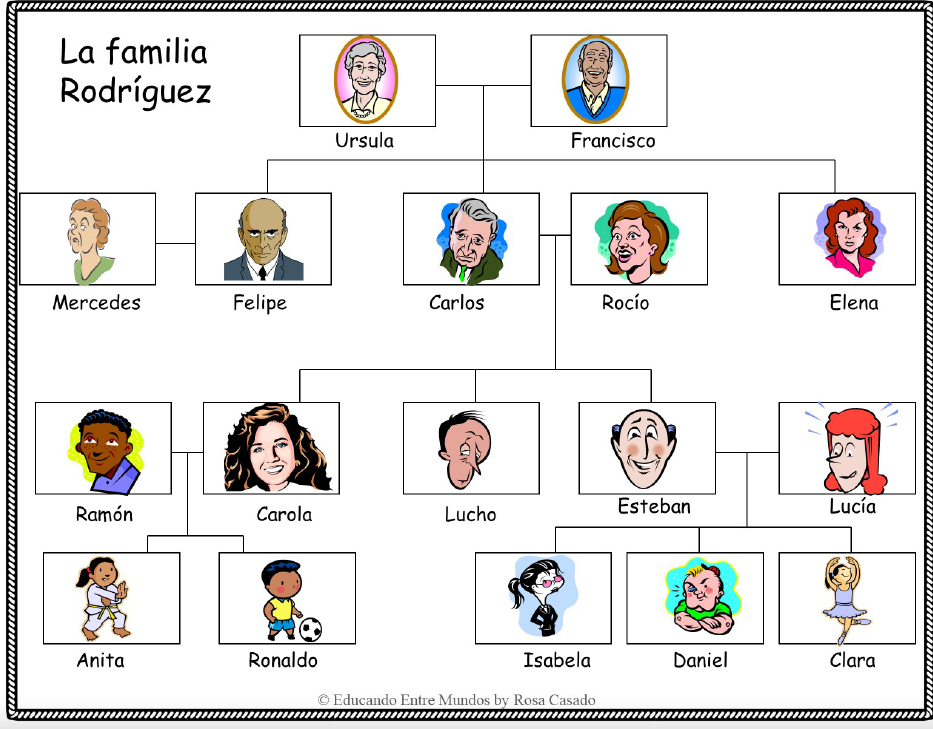
¡Hola! Me llamo Clara y soy de Ecuador. Tengo 8 años y me gusta bailar. Tengo dos hermanos: una hermana que se llama Isabela y un hermano que se llama Daniel. Mis padres se llaman Lucía y Esteban. Ellos son ecuatorianos. También (also) tengo dos abuelos, dos abuelas y dos bisabuelos. Mi pariente favorito es mi tío Lucho.
ACTIVIDAD # 1
*Look at the Rodríguez family tree and choose the letter that best completes the sentence.
1. Ronaldo es el ___de Anita. 2. Úrsula es la ___ de Clara.
a. primo b. sobrino a. abuela b. bisabuela
c. hermano d. cuñado c. sobrina d. madrastra
3. Carola es la ___de Lucía. 4. Felipe es el ___ de Esteban.
a. suegra b. sobrina a. tío b. padre
c. hermana d. cuñada c. suegro d. hermano
5. Lucho está soltero. 6. Carola y Ramón tienen una hija.
a. Cierto b. Falso a. Cierto b. Falso
¡Inténtalo!
ACTIVIDAD # 2
With a partner, answer the following questions about the Rodríguez family.
- ¿Cómo se llama la hermana de Ronaldo?
- ¿Cómo se llaman los abuelos de Anita?
- ¿Cómo se llama el hijo de Lucía? ¿Elena está casada?
- ¿Cuántos (how many) hijos tienen Ramón y Carola?
- ¿Tienen hijos Mercedes y Felipe?
* Copyright: Educando entre Mundos by Rosa Casado
ACTIVIDAD # 3
ACTIVIDAD # 4
Relacionar. Match the two columns by selecting the word in Spanish for each family member from column A.
A
|
B
—-primo
|
|---|
¡Inténtalo!
ACTIVIDAD # 5
Seleccionar. Choose the word that does not belong to the group.
|
hijastra
pareja tío novio hijo casado suegro sobrino padrastro mascota |
tata
esposa suegra nieto madre divorciado media naranja tía tatarabuelo gato |
madrastra
nieta cuñada nana papá nuera yerno sobrina nana perro |
|---|
¡Inténtalo!
ACTIVIDAD # 6
¿Quién es? Complete the following sentences logically.
- La madre de mi madre es mi (my) . . .
- Los hijos de mis (my) tíos son mis . . .
- La esposa de mi hermana es mi . . .
- El esposo de mi abuela es mi . . .
- Los hermanos de mi papá son mis . . .
ACTIVIDAD # 7
¡Hablemos! With a classmate, take turns asking each other the following questions.
Estudiante A
- ¿Tu familia es grande o pequeña?
- ¿Eres casado/a, soltero/a, divorciado/a?
- ¿Tienes hijos? ¿Cuántos? ¿Cómo se llaman?
- ¿Cuántos hermanos tienes? ¿Cómo se llaman?
- ¿Tienes muchos primos? ¿Cuántos?
- ¿Quién es tu pariente (relative) favorito? ¿Cómo se llama? ¿Cuántos años tiene?
Estudiante B
- ¿Cómo se llama tu mamá (madre) y tu papá (padre)?
- ¿Tienes muchos tíos/tías? ¿Quién es tu tío/a favorito/a?
- ¿Cuántas personas hay en tu familia?
- ¿Tienes abuelos? ¿Cómo se llama tu abuela?
- ¿Cuántos sobrinos tienes?
- ¿Quién es tu pariente (relative) favorito? ¿Cómo se llama? ¿Cuántos años tiene?
ACTIVIDAD # 8
Y ahora ustedes?
¿Cómo es tu familia? ¿Es grande o pequeña?
¿Tienes hermanos o hermanas o eres hijo/a único/a?
¿Cuántos años tienen? ¿Son mayores (más grandes) o menores (más pequeños) tus hermanos?
¿Tienes hijos o hijas? ¿Cómo se llaman?
Pronunciación
The consonants r and rr
- The pronunciation of the consonant “r” in Spanish is similar to the double “t” in words like “butter” and “petty”.
- Now, at the beginning of a word or after E or N, it is pronounced with a trill.
For example, reservado sonrisa
- The “rr” is always pronounced with a trill, as in “carro”.
ACTIVIDAD # 1
Escuche y repita. Listen and repeat after the instructor the following words.
-
- rubio
- gordo
- perro
- amarillo
- aburrido
- burrito
- cierto
ACTIVIDAD # 2
Escuche y marque la diferencia. Circle the word you hear your instructor pronounce in each of the following word pairs.



Note: Additional practice of words with “R” and “RR”. Click here to practice the R and RR sounds
Mosaicos culturales: Los compadres
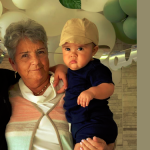
The concept of Godparents in Spanish-speaking countries
Padrino and Madrina are two Spanish words for Godfather and Godmother, a traditional role throughout Latin America when a trusted adult is chosen by the parents to help with the care and development of a child. A godparent is often an honorary title in Anglo-American culture, their main responsibility being participation in the baptism ceremony. In Latin American culture, it is quite the opposite. Godparents are involved in many aspects of the child’s life – for their entire life, and they create a strong bond with the parents as well. The word for godchild in Spanish is Ahijado and Ahijada. Parents and godparents call each other compadre and comadre.
Selecciona (V) verdadero o (F) falso:
- “Los Padrinos” are chosen only for religious purposes. (V) (F)
- The “ahijados” usually keep in contact with their godparents throughout their lives. (V) (F)
- The relationship between the parents and the godparents of their children is called “compadres” (V) (F)
Y ahora ustedes…
- ¿Es común tener un padrino o madrina en tu país?
- ¿Tienes una persona especial en tu familia? ¿Quién es?
3.1 Gramática: Possessive Adjectives
| 1. Possessive adjectives express the quality of ownership or possession. They agree in number with the nouns they modify (****and with gender just with the nuestro and vuestro form). |
|---|
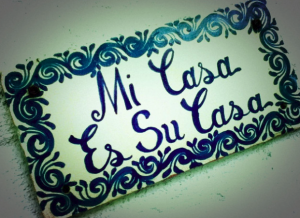
| Use with Singular nouns | Use with Plural nouns | |
|---|---|---|
| mi | mis | my |
| tu | tus | your (familiar) |
| su | sus | his, her, its, your (formal) |
| *nuestro/a |
nuestros/as | our |
| *vuestro/a | vuestros/as | your (in Spain) |
| su | sus | their, your |
ACTIVIDAD # 1
ACTIVIDAD # 2
Escribir. Using the appropriate possessive adjective, say to whom the following belong:
Ejemplo: la computadora / mi hermana = Su computadora.
- Los libros / José ______________________.
- La casa / mis padres ___________________.
- La profesora / de nosotros _______________.
- El esposo / de Ángela ___________________.
- Los amigos / de ustedes _________________.
- Las clases / yo ________________________.
ACTIVIDAD # 3
Responder. Answer the following questions using the appropriate possessive adjective.
- ¿Cómo se llama tu mamá?
- ¿Cuántos años tiene tu papá?
- ¿Quién es tu mejor (best) amigo(a)?
- ¿Cuál es tu nacionalidad?
- ¿Cuál es la nacionalidad de tus padres?
| 2. Possession with “de” |
|---|
A. There is no apostrophe used in Spanish to express possession. It is normally expressed by using:
article + noun + de + name
Ejemplo: El libro de Alberto = Alberto’s book.
La casa de la familia García = García’s family house
B. When the preposition “de” is followed by the masculine article “el” (the), the contraction “del” is formed:
Ejemplo: El suéter del niño = The kid’s sweater.
C. When followed by the verb “SER” (To Be), the equivalent of “Whose” is: ¿De quién? Or ¿De quiénes?
Ejemplo: ¿De quién es el lápiz? = Whose is this pencil?
¿De quiénes son las cajas? = Whose are the boxes?
ACTIVIDAD # 1
Traducir. Translate the following phrases into Spanish.
- My parents’ house ______________________________________________.
- My dad’s car ____________________________________________________.
- My friend’s party _______________________________________________.
- My pet’s toys (juguetes) _________________________________________.
- María’s cat ______________________________________________________.
3.2 Gramática: Descriptive Adjectives
Adjectives describe nouns and agree in number (singular or plural) and gender (masculine or feminine) with the nouns they modify.
| SINGULAR | PLURAL | |
|---|---|---|
| MASCULINE | El niño es alto | Los niños son altos |
| FEMININE | La niña es alta | Las niñas son altas |
A. Position
1. Descriptive adjectives generally follow the noun they describe.
Ejemplo:
una chica guapa a pretty girl un señor mexicano a Mexican man
2. Adjectives expressing number or quantity generally come before the noun.
Ejemplo: mucho dinero much money tres muchachas three girls
B. Agreement of adjectives
1. In Spanish, the descriptive adjectives agree in gender and number with the nouns or pronouns they describe.
Ejemplo:
Pedro es simpático Pedro is nice María es simpática María is nice
Ellos son simpáticos They are nice
2. Adjectives ending in –o change to -a when describing a feminine singular noun.
Ejemplo:
Carlos es guapo Carlos is handsome Lucía es guapa Lucía is pretty
3. The plural is formed by adding -s when ending in a vowel and -es when ending in a consonant.
Ejemplo:
El niño es fuerte The kid is strong Los niños son fuertes The kids are strong
Él es trabajador He is hardworking Ellos son trabajadores They are hardworking
4. Adjectives ending in –e remain the same when describing a feminine singular noun.
Ejemplo:
Luis es inteligente Luis is intelligent Marta es inteligente Marta is intelligent
Note: Use the masculine plural to refer to groups that include males and females.
| Ejemplo: José es bajo | José is short |
|---|---|
| María es baja | María is short |
| José y María son bajos | José and María are short |
Commonly Used Adjectives
| Características | Characteristics | Características | Characteristics |
| alto (a) | tall | bajo (a) | short |
| delgado (a) | slim | gordo (a) | chubby |
| bonito (a) | cute/pretty | feo (a) | ugly |
| guapo (a) | handsome/good looking | medio guapo (a) | not so good looking |
|---|---|---|---|
| Personalidad | Personality | ||
| bueno(a) | good | malo (a) | bad |
| débil | weak | fuerte | strong |
| difícil | difficult | fácil | easy |
| joven | young | viejo(a) / mayor | old |
| inteligente | smart | tonto (a) | foolish / silly |
| paciente | patient | impaciente | impatient |
| responsable | responsible | irresponsable | irresponsible |
| rico (a) | rich | pobre | poor |
| generoso (a) | generous | tacaño (a) / codo (a) | cheap / frugal |
| *optimista | optimistic | *pesimista | pessimistic |
| interesante | interesting | aburrido (a) / soso (a) | boring / bland |
| liberal / moderno (a) | liberal / modern | conservador (a) | conservative |
| divertido (a) | fun | aburrido (a) | boring |
| tolerante | tolerant | intolerante | intolerant |
| amable / simpático (a) | kind / nice | descortés / antipático (a) | unpleasant / unkind |
| terco (a) | stubborn | flexible | flexible |
| trabajador (a) | hardworking | perezoso (a) | lazy |
Adjectives of nationality
NOTE: Spanish adjectives of nationality are NOT capitalized.
| Masculine | Feminine | |
|---|---|---|
| argentino(s) | argentina(s) | Argentinean |
| boliviano(s) | boliviana(s) | Bolivian |
| colombiano(s) | colombiana(s) | Colombian |
| costarricense(s) (tico) | costarricense(s) (tica) | Costarican |
| cubano(s) | cubana(s) | Cuban |
| dominicano(s) | dominicana(s) | Dominican |
| ecuatoriano(s) | ecuatoriana(s) | Ecuadorian |
| español(es) | española(s) | Spanish |
| estadounidense(s) | estadounidense(s) | American |
| guatemalteco(s) | guatemalteca(s) | Guatemalan |
| mexicano(s) | mexicana(s) | Mexican |
| nicaraguense(s) | nicaraguense(s) | Nicaraguan |
| panameño(s) | panameño(s) | Panamanian |
| puertorriqueño(s) (boricua) | puertorriqueña(s) (boricua) | Puerto Rican |
| salvadoreño(s) | salvadoreña(s) | Salvadorean |
| alemán alemanes |
alemana(s) | German |
| inglés ingleses |
inglesa(s) | English |
| irlandés irlandeses |
irlandesa(s) | Irish |
ACTIVITY # 1
Emparejar. Match the two columns based on their opposites:
COLUMN A
|
COLUMN B
a. nuevo |
|---|
ACTIVITY # 2
¡Así es mi familia! Write a sentence with the verb TO BE (Ser) using the following nouns and adjectives.
Attention to the gender and number agreement.
- Mi padre/ divertido
- Mis hermanos / tímido
- Mis sobrinas / bonito
- Mi abuela y mi abuelo / trabajador
- Toda mi familia / amable
- Yo / responsable
ACTIVITY # 3
ACTIVITY # 4
Las nacionalidades. Completar: Indicate the nationalities of these people. Use the correct adjective and make any changes when necessary.
- Serena y Venus Williams son____________________.
- Shakira es una cantante ________________________.
- Rafael Nadal es _________________________________.
- Ricky Martin es_________________________________.
- Sammy Sosa es ________________________________.
ACTIVIDAD # 5
Nacionalidades. Look at the following map of Latin America and write the nationalities of each student. Attention to the gender and number agreement.

- Alba es _________________________________.
- Carlos y Flor son ________________________.
- Lucas es ________________________________.
- José es _________________________________.
- Lucas es ________________________________.
- Inés es __________________________________.
- Ana y Cristina son _______________________.
- Felipe es _________________________________.
- Natalia y Fabio son _______________________.
ACTIVIDAD # 6
Cultura. With a partner, look at the painting from Colombian artist Fernando Botero and take turns responding to the following questions.

- 1. ¿Cómo se llama el artista?
- ¿Cómo se llama la pintura?
- ¿Qué hay en la pintura?
- ¿Es una familia grande o pequeña? ¿Por qué?
- ¿Cómo es la mamá? ¿es rubia, morena o pelirroja?
- ¿El perro es gordito o delgado? Y ¿el niño?
ACTIVIDAD # 7
Encuesta: La familia, la edad y la nacionalidad. Go around the room and interview five (5) of your compañeros about their parents, their age, and nationality. Write the answers in the chart.
Ejemplo: Estudiante 1: ¿Cómo se llaman tus padres?
Estudiante 2: Mi papá se llama _____ y mi mamá se llama _____.
Estudiante 1: ¿Cuántos años tienen?
Estudiante 2: Mi padre tiene _____ años y mi madre tiene____ años.
Estudiante 1: ¿Cuál es su nacionalidad?
Estudiante 2: Mi padre es ________y mi madre es_________.
o mis padres son_______________.
| Nombre de su compañer@ |
Nombre de su mamá |
edad (age) | Nombre de su papá |
edad | Nacionalidad de su papá |
Nacionalidad de su mamá |
|---|---|---|---|---|---|---|
|
|
||||||
|
|
||||||
|
|
||||||
|
|
||||||
|
|
ACTIVIDAD # 8 Write-Share
Use the verb SER and ADJECTIVES to describe one family member, one friend, and yourself. Be prepared to share with the class.
1. Un familiar:
2. Un (a) amig@:
3. Yo:
3.3 Present tense of -ER and -IR verbs
A. -ER Verbs. The present tense of regular -ER ending verbs is formed by dropping the ending -ER and adding the following:
APRENDER (to learn)
| Singular | Plural | ||
| Yo | aprendo | Nosotros (as) | aprendemos |
| Tú | aprendes | Vosotros (as) | aprendéis |
|---|---|---|---|
| Él, Ella, Usted | aprende | Ellos, Ellas, Ustedes | aprenden |
The following is a list of common regular -ER verbs in Spanish:
| Aprender a | to learn | Deber | must; should |
| Beber | to drink | Depender de | to depend on |
| Comer | to eat | Leer | to read |
|---|---|---|---|
| Comprender | to comprehend; to understand | Prometer | to promise |
| Correr | to run | Responder | to respond |
| Creer | to believe | Vender | to sell |
B. -IR Verbs. The present tense of regular -IR ending verbs is formed by dropping the ending -IR and adding the following:
ESCRIBIR (to write)
| Singular | Plural | ||
| Yo | escribo | Nosotros (as) | escribimos |
| Tú | escribes | Vosotros (as) | escribís |
|---|---|---|---|
| Él, Ella, Usted | escribe | Ellos, Ellas, Ustedes | escriben |
The following is a list of common regular -IR verbs in Spanish:
| Abrir | to open | Escribir | to write |
|---|---|---|---|
| Asistir a | to attend | Insistir en | to insist on |
| Compartir | to share | Permitir | to permit; to allow |
| Decidir (+ inf.) | to decide | Recibir | to receive |
| Descubrir | to discover | Subir | to go up, to climb, to raise |
| Describir | to describe | Vivir | to live |
| Dividir | to divide |
Verb Chart. You can practice conjugating -ER and -IR verbs using the following chart.
| Verb (English) | Verbo (español) | Yo | Tú | Él, Ella, Usted (Ud.) | Nosotros(as) | Ellos, Ellas, Ustedes (Uds.) |
|---|---|---|---|---|---|---|
|
|
||||||
|
|
||||||
|
|
||||||
|
|
||||||
|
|
||||||
|
|
||||||
|
|
||||||
|
|
||||||
|
|
ACTIVIDAD # 1
Oraciones. Miguel and Sandra explain to their parents what they do in school every day. Please conjugate the verbs accordingly:
- El profesor / escribir en la pizarra. ________________________.
- Los estudiantes /responder en español. _____________________.
- Nosotros / compartir el libro. ___________________________.
- Yo / insistir en estudiar mucho. __________________________.
- Alejandro / decidir hablar en inglés. _______________________.
ACTIVIDAD # 2
Contestar. Answer the following questions:
- ¿Tú comes en tu casa o en la cafetería de la universidad?
- ¿Tus padres viven en Arizona?
- ¿Los estudiantes escriben en el cuaderno o en el libro?
- ¿Tú respondes las preguntas del profesor en inglés o en español?
- ¿Tú aprendes mucho en la clase de español?
ACTIVIDAD # 3
Completar. Select the appropriate -ER or -IR verb and write a sentence in the present tense based on the people and the activity they do:
| Escribir Aprender Vivir Leer
Asistir Correr Comer Beber |
|---|

Patricia |
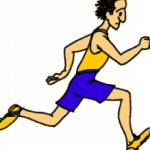
Pablo |

La mamá |

Nosotros |

Los niños |

Isabel |

Juan Pablo |

El señor Rodríguez |
|---|
ACTIVIDAD # 4
Escribir. Write the questions that originated the following answers:
- ________________________________________.
Yo vivo en Phoenix, Arizona. - _________________________________________.
No, el profesor no permite usar el teléfono en la clase. - _________________________________________.
Sí, mi hermano y yo leemos libros en español. - _________________________________________.
Sí, yo asisto a una universidad en California.
5._________________________________________.
Bebo café por la mañana.
ACTIVIDAD # 5 ¡Hablemos!
With a partner, take turns asking and responding to the following questions:
Estudiante A
- ¿Dónde vives?
- ¿Cuántas clases debes tomar el próximo (next) semestre?
- ¿Recibes muchos textos? ¿Cuántos al día?
- ¿Cuántos idiomas comprendes?
- ¿Qué días asistes a la universidad?
Estudiante B
- ¿Escribes mucho en español?
- ¿Asistes a clases los lunes?
- ¿Dónde comes tu almuerzo (your lunch) normalmente?
- ¿Lees libros por diversión o por obligación?
- ¿Dónde vive tu familia?
3.4 Gramática: Present tense of TENER and VENIR
The verb tener (to have) and venir (to come) are frequently used in Spanish. Their forms are irregular.
TENER (to have)
| Singular | Plural | ||
|---|---|---|---|
| Yo | tengo | Nosotros (as) | tenemos |
| Tú | tienes | Vosotros (as) | tenéis |
| Él, Ella, Usted | tiene | Ellos, Ellas, Ustedes | tienen |
1. The verb TENER can be used to express obligation by adding QUE + a second verb (non-conjugated):
Ejemplos: Tengo que trabajar mañana (I have to work tomorrow)
¿Tienes que estudiar? (Do you have to study?)
2. The verb TENER can be used to express to feel like doing something by adding GANAS DE + a second verb (non-conjugated):
Ejemplos: Tengo ganas de comer tacos de pescado (I feel like eating fish tacos)
¿Tienes ganas de estudiar conmigo? (Do you feel like studying with me?)
3. The verb TENER is also used to express some feelings and certain expressions:
| Tener hambre | to be hungry | Tener sed | to be thirsty |
|---|---|---|---|
| Tener calor | to be hot | Tener frío | to be cold |
| Tener prisa | to be in a hurry | Tener miedo | to be afraid or scared |
| Tener razón | to be right | Tener sueño | to be sleepy |
| Tener éxito | to be successful | Tener suerte | to be lucky |
| Tener cuidado | to be careful | Tener … años | to be … years old |
VENIR (to come)
| Singular | Plural | ||
|---|---|---|---|
| Yo | vengo | Nosotros (as) | venimos |
| Tú | vienes | Vosotros (as) | venéis |
| Él, Ella, Usted | viene | Ellos, Ellas, Ustedes | vienen |
The verb venir can be used with the preposition “a” (to come to) or “de” (to come from)
Ejemplo: Vengo a clase los lunes (I come to class on Mondays)
Vengo de la casa (I come from my house)
ACTIVIDAD # 1
TENER. Circle the appropriate form of TENER to complete each sentence.
- Pedro (tengo / tiene) una clase a las 10 de la mañana.
- Nosotros no (tenemos / tiene) mucho dinero.
- Ella (tienen / tiene) 25 años.
- Ustedes (tienen / tiene) muchos libros.
- Mi familia y yo (tenemos / tienen) que beber más agua.
ACTIVIDAD # 2
Oraciones. Conjugate the verbs accordingly to create full sentences.
1. Yo / tener clases todos los viernes.
_____________________________________________.
2. Ana y Miguel / venir al partido de fútbol con su familia.
_____________________________________________
3. Carlos / tener muchos amigos de México.
_____________________________________________.
4. Nosotros / venir a la clase de español todas las semanas.
_____________________________________________.
5. Yo / venir de mi casa, ¿y tú?
_____________________________________________.
ACTIVIDAD # 3
¿Qué tienen? Describe how these people feel, using the appropriate expression with TENER.
 |
 |
 |
|---|---|---|
 |
 |
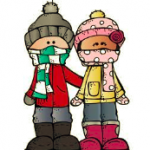 |
ACTIVIDAD # 4
Las situaciones. Which expression with TENER would you use in each of the
following situations?
- You are in Phoenix in August, and the temperature is 110°F.
- You are in Alaska in the middle of winter.
- You have only three minutes to get to your next class.
- You have not eaten in 12 hours.
- You have won the lottery.
ACTIVIDAD # 5
Preguntas. Get together with a compañer@ and ask each other these questions.
- ¿Tú vienes a la universidad todos los días?
- ¿Cuándo vienes a la clase de español?
- ¿De qué tienes miedo?
- ¿Tienes que trabajar hoy (today)?
- ¿Qué tienes ganas de hacer (to do) esta noche (tonight)?
- ¿Tú tienes una mascota en casa? ¿Cuál?
ACTIVIDAD # 6
¡Hablemos! Preguntas de repaso. With a partner, take turns asking and responding to the following questions:
Estudiante A
- ¿Tienes una familia grande?
- ¿Cómo se llaman tus padres?
- ¿Bebes café todos los días?
- ¿Qué tienes que hacer (to do) hoy?
- ¿Dónde vives?
Estudiante B
- ¿Cuántos hermanos tienes?
- ¿Asistes a clases los lunes?
- ¿Qué comes para el almuerzo (your lunch) normalmente?
- ¿Tienes novio (a)/ esposo (a)/ media naranja? ¿Cómo se llama?
- ¿Qué tienes ganas de hacer (to do) esta noche (tonight)?
Cultura: Ecuador
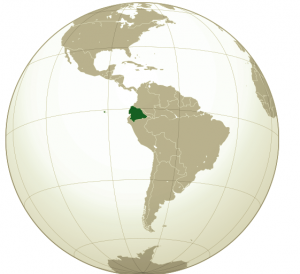
Ecuador
Guayaquil Datos Curiosos: The Galapagos Islands (home of the giant turtles and the blue booby) belong to Ecuador and are located about 600 miles from the coast.
 |
|---|
Música: Mirella Cesa
Mirella Cesa is a songwriter from Ecuador, with over 10 years as an artist, she is known as “The mother of “Andi-pop”, this is the fusion between pop and Andes music, her basic instruments are charango, zampona, the drums, electric guitars, and the bass.
Canción: Corazón abierto
Como agua que baja del cerro hasta el río
Como una semilla que en tierra germina
Marco yo mi paso, labro mi camino
Buscando a ese par que me dio su costilla
Tengo activado todos mis sentidos
Para detectarte si es que te aproximas
Robarte la risa será mi objetivo
Mirarte los ojos será ir al clímax En mi trayecto el sol sale
Es la señal para que no desmaye
Tengo tanto para darte
Solo tengo que encontrarte
Traigo el corazón abierto y cargado de deseo
Es muy grande lo que siento
Ya no puedo contenerlo
Tengo en una gran alegría
Crece y crece cada día
Mi barca esta a la deriva
Quiero entrarme en tu orilla
Ya te veo a lo lejos como un espejismo
Mi brújula interna hacia a ti me guía
Te vi en mi sueños, te encontré en mis libros
Y en aquellos cuentos que leía de niña
En mi trayecto el sol sale
Es la señal para que no desmaye
Tengo tanto para darte
Solo tengo que encontrarte
Traigo el corazón abierto y cargado de deseo
Es muy grande lo que siento
Ya no puedo contenerlo
Tengo en una gran alegría
Crece y crece cada día
Mi barca esta a la deriva
Quiero entrarme en tu orilla
Lalarei lalarei ohhhhhhh.
Traigo el corazón abierto y cargado de deseo
Es muy grande lo que siento
Ya no puedo contenerlo
Tengo en una gran alegría
Crece y crece cada día
Mi barca esta a la deriva
Quiero entrarme en tu orilla
Personalidad: Oswaldo Guayasamín
Press play to listen to the pronunciation of the reading in the paragraph written below.
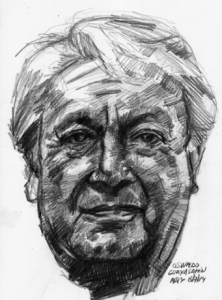
(Quito, 1919 – Baltimore, 1999) Pintor ecuatoriano. Comienza a pintar y dibujar desde su infancia (childhood) y vende sus trabajos a los turistas para pagar sus estudios. Estudia en la Escuela de Bellas Artes de Quito por siete años y recibe el título de pintor y escultor en 1941.
En sus cuadros (paintings) Guayasamín denuncia siempre con convicción los horrores, los desastres y los dramas del hombre, dando a sus obras una expresividad particular dentro de la escuela indigenista.
Preguntas de Comprensión. After reading the short biography of Oswaldo Guayasamín, answer the following questions.
1.¿Cuál es la nacionalidad de Oswaldo Guayasamín?
____________________________________________.
2. ¿Cómo paga Guayasamín por sus estudios?
_____________________________________________.
3. ¿En qué año termina su carrera de pintor y escultor?
____________________________________________.
4. ¿Cuáles son los temas (themes) en la obra de Guayasamín?
____________________________________________.
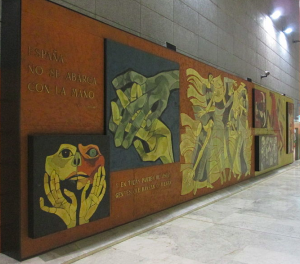
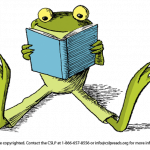 Lectura: Hispanic Names ¡Vamos a leer!
Lectura: Hispanic Names ¡Vamos a leer!
Press play to listen to the pronunciation of the reading in the paragraph written below.
¿Cuál es tu apellido (last name)?
En el mundo hispanohablante es muy común tener dos apellidos: el paterno (del padre) y el materno (de la madre). Generalmente se escribe el apellido paterno primero y después el materno. Por ejemplo, Alejandro García López: el apellido del padre es García y el de la madre es López. Esta (this) tradición del doble apellido (two last names) es original de España, pero en Latinoamérica es muy popular también (excepto en Argentina).
Cuando una mujer se casa (gets married), es posible usar el apellido de su esposo o también usar “de” para conectarlos. Por ejemplo, Marta Lucía Guerrero se casa con Pedro Serrano Parra, ella puede cambiar a: Marta Lucía Guerrero de Serrano o Marta Lucía Guerrero Serrano. Hoy en día (nowadays), en los países de Latinoamérica o en España, muchas mujeres NO cambian su apellido.
En conclusión, es muy común mantener los apellidos paterno y materno en las familias hispanohablantes.
ACTIVIDAD # 1
With a partner, read the above passage and answer the following questions based on the reading:
- ¿Cuántos apellidos usan las personas en España y Latinoamérica?
- ¿El apellido materno se escribe primero (first) o segundo (second)?
- La tradición del doble apellido se usa en todos los países (all countries) de Latinoamérica?
- Generalmente, ¿una mujer casada usa el apellido de su esposo?
- ¿El apellido más usado es el paterno o el materno?
CULTURA. If it seems that Hispanic people have longer names than their English-speaking counterparts, it’s because they usually do. One extreme example is Pablo Picasso. His full name is “Pablo Diego José Francisco de Paula Juan Nepomuceno María de los Remedios Cipriano de la Santísima Trinidad Ruiz y Picasso.”
Hispanic names tell a story. You can learn a lot about Spanish speakers from their full names. To learn more about Spanish Names and Last Names, click on the following link.
Spanish Last Names (Surnames)

